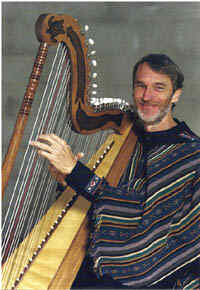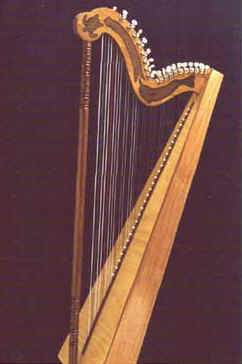INTRODUCTION TO THE PARAGUAYAN HARP
The Paraguayan Harp is relatively new to the western harp world. It originates
from Paraguay, a land locked country in South America sandwiched between Brazil
Argentina and Chile.
The Spanish took the folk harp to South America in the 15th
and 16th centuries. In Paraguay the folk harp has remained a popular
instrument to this day, remaining a living tradition unlike most parts of Europe
and America where the harp had faded from popular culture by the mid nineteenth
century
Most folk harp activity in Europe and America today has its origins in the
revival of folk traditions during the mid 20th century.
The Paraguayan harp has its origins in the old Spanish harps
and European minstrel harps which had a straight round pillar. However its present
design and construction date from the early/mid 20th century. Especially
the unique divided neck, with the strings passing vertically between them and
nylon/nylon wrapped strings for the bass notes.. This permits a light and strong
harp with magnificent tone and volume.
See photo
To Paraguayan Harps Page

PARAGUAYAN HARP PLAYING TECHNIQUE
The technique for playing the Paraguayan Harp differs from most other folk
harps.
First the fingernails are normally used to pluck the strings
similar to a classical guitar The fingers are held in a hooked fashion and a
light plucking or squeezing is used The string tension is lower than many other
harps allowing a light and relaxed style of playing.
It is common to play the melody line using octaves or thirds
and sixths, giving a characteristic brilliant sound. Tremolos are quite
common, often played in harmony against a melodic or rhythmic bass line. Not
unlike the romantic classic guitar tremolo style
Some old welsh triple harp music is played this way also. There
could have been some influence as there are villages in Paraguay where Welsh
people have been living for over 100 years.
STYLE OF MUSIC I PLAY
My style of music grew out of being isolated from other harp
players and not having a teacher. I simply started composing pieces to play.
The style is hard to put in a category, although it contains elements of Celtic,
Paraguayan and other folk music, classical and new age. This has worked
against me at times, as people want to put things in boxes. Especially promoters!
I call it contemporary romantic folk music
My music is an expression of an inner energy, which seeks to
express itself, both for my enjoyment and others as well. The great thing about
harp music is its melodic beauty and its ability to provide a feeling
of peace and beauty in the listener. People from Europe have been
very appreciative of my music.
The bass line is often rhythmic. A lot of my music uses Paraguayan
elements as well as a lot of the ancient Celtic harp playing methods also, i.e.
repeated notes, strong bass chords and using various modes. Also the
close spacing of the strings allows very fast arpeggios wide chord
reaching (easily 1Ĺ octaves), fast scale like runs, and fluid tremolos.

HOW I CAME TO FALL IN LOVE WITH IT
Originally I played the classical guitar. However, I was not
a particularly successful guitarist. I first heard the Celtic harp on a record
by Allan Stivell over 14 years ago. This music enchanted me. Eventually
the desire to play the harp arose. I planned to obtain a Celtic harp as that
was the only kind of folk harp I knew of..
As fate would have it, a friend told me of a harp-building
workshop. They were building small Paraguayan harps. These were new to me, but
I was immediately attracted to them as playing them wasnít that much different
to playing the guitar and I just loved the music being played on them.
As time went by and my repertoire outgrew the small harp, the
time came to build a bigger one. So plans were obtained from America and a full
size Paraguayan harp was built. Also I started building harps for customers.
These days I make Paraguayan and ancient Celtic harps. Both are decorated with
a mixture of traditional and my original designs.
PARAGUAYAN HARP CONSTRUCTION
Paraguayan harps are lightweight, less than 6kgs for a
36-string model. The divided neck means there is no lateral force on the
instrument. So the neck pillar and body are held together by the tension of
the strings. The sound box is built with thin wood for the back and top 3-5
mm the sides may be thicker 6mm for rigidity and to increase sustain. Various
woods have been used each adding its own colour to the sound of the harp.
Despite the frail construction the harps are strong
and are easy to carry around using the pillar as a handle.
Also modern Paraguayan harps often use guitar machine
heads to tune the strings These may offends traditionalists but they allow
stable and precise tuning .In Australia, the split neck harp is very popular
using machine heads even on Celtic harps.

Because the neck and pillar of the Paraguayan Harp are
not glued together it is possible to loosen the strings and pack the harp in
a small box for shipping. This saves a fortune in freight costs because the
freight companies charge by volume not weight. I have sent harps to Europe for
moderate cost.
Robert lives near Byron bay Australia in a beautiful
rural area which provides inspiration for music and craft
For information on harps and to how to purchase his CDís, contact
him at PO BOX 583 Mullumbimby NSW 2482 Australia, or phone/fax 61-2-6684,1783





